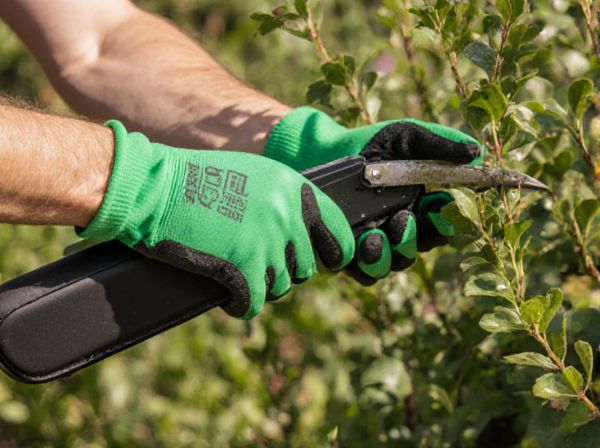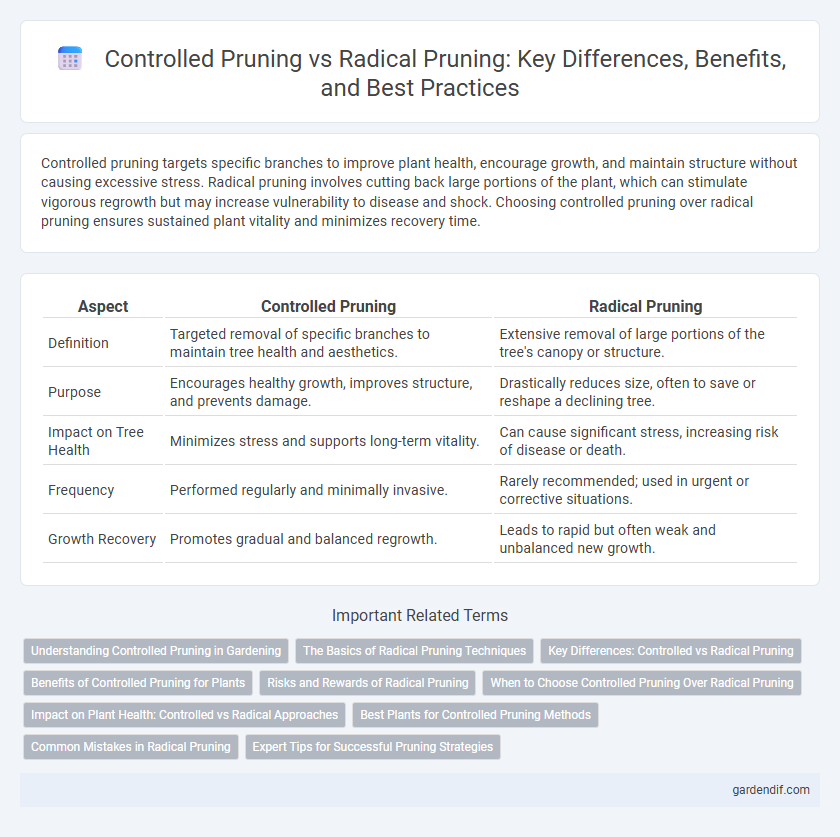
Controlled pruning vs radical pruning Illustration
Controlled pruning targets specific branches to improve plant health, encourage growth, and maintain structure without causing excessive stress. Radical pruning involves cutting back large portions of the plant, which can stimulate vigorous regrowth but may increase vulnerability to disease and shock. Choosing controlled pruning over radical pruning ensures sustained plant vitality and minimizes recovery time.
Table of Comparison
| Aspect | Controlled Pruning | Radical Pruning |
|---|---|---|
| Definition | Targeted removal of specific branches to maintain tree health and aesthetics. | Extensive removal of large portions of the tree's canopy or structure. |
| Purpose | Encourages healthy growth, improves structure, and prevents damage. | Drastically reduces size, often to save or reshape a declining tree. |
| Impact on Tree Health | Minimizes stress and supports long-term vitality. | Can cause significant stress, increasing risk of disease or death. |
| Frequency | Performed regularly and minimally invasive. | Rarely recommended; used in urgent or corrective situations. |
| Growth Recovery | Promotes gradual and balanced regrowth. | Leads to rapid but often weak and unbalanced new growth. |
Understanding Controlled Pruning in Gardening
Controlled pruning in gardening involves selectively removing specific branches to enhance plant health, shape growth, and improve fruit or flower production while minimizing stress to the plant. This method contrasts with radical pruning, which entails severe cutting back that can shock the plant and delay recovery. Understanding controlled pruning techniques allows gardeners to promote balanced growth and maintain the plant's structural integrity effectively.
The Basics of Radical Pruning Techniques
Radical pruning techniques involve the aggressive removal of large portions of a plant's structure to stimulate vigorous new growth and improve overall health. This method is often applied during dormant seasons to minimize stress and allows rapid rejuvenation, especially for overgrown or poorly maintained plants. Key techniques include cutting back main branches to strong buds or the trunk, promoting regenerative shoots and enhancing long-term productivity.
Key Differences: Controlled vs Radical Pruning
Controlled pruning targets specific branches to enhance overall plant health and shape, promoting balanced growth with minimal stress. Radical pruning involves extensive cutting of large portions, often leading to quicker rejuvenation but higher shock and potential recovery time. The key differences lie in intensity, recovery rate, and impact on the plant's structural integrity.
Benefits of Controlled Pruning for Plants
Controlled pruning enhances plant health by selectively removing specific branches, which improves air circulation and light penetration, reducing the risk of disease. This method supports sustained growth and fruit production by preserving the plant's natural structure and energy reserves. Unlike radical pruning, controlled pruning minimizes stress, promoting quicker recovery and long-term vitality.
Risks and Rewards of Radical Pruning
Radical pruning involves the removal of a significant portion of a plant's structure, which can rapidly rejuvenate overgrown or poorly maintained trees but carries substantial risks such as increased vulnerability to diseases, stress-induced decline, and potential death. The rewards include stimulating vigorous new growth, improving light penetration, and correcting structural problems quickly. Proper timing, technique, and post-pruning care are critical to minimize the hazards associated with radical pruning and maximize its benefits.
When to Choose Controlled Pruning Over Radical Pruning
Controlled pruning is preferred when maintaining structural integrity and long-term health of the plant is essential, especially for young or fruit-bearing trees. It allows gradual shaping and removal of dead or weak branches without causing severe stress or shock. Choose controlled pruning to promote sustainable growth and avoid the risks associated with radical pruning, such as excessive canopy loss or vulnerability to pests and diseases.
Impact on Plant Health: Controlled vs Radical Approaches
Controlled pruning selectively removes specific branches to enhance air circulation, sunlight penetration, and overall plant vigor, minimizing stress and supporting sustainable growth. Radical pruning, involving extensive branch removal, can lead to shock, increased vulnerability to diseases, and delayed recovery due to the plant's stress response. Selecting controlled pruning techniques promotes long-term plant health by balancing aesthetic goals with the preservation of essential foliage and structural integrity.
Best Plants for Controlled Pruning Methods
Controlled pruning involves selectively removing specific branches to maintain plant health and shape, making it ideal for delicate species such as roses, hydrangeas, and fruit trees like apple and pear. These plants benefit from precise cuts that encourage flowering and fruit production without stressing the overall structure. Radical pruning suits more resilient species, but roses and fruit trees thrive best under controlled pruning methods that promote sustainable growth and vitality.
Common Mistakes in Radical Pruning
Radical pruning often leads to common mistakes such as excessive removal of branches, which can cause stress and increased vulnerability to diseases in plants. Unlike controlled pruning that targets specific limbs for healthy growth, radical pruning risks damaging the plant's structural integrity and reduces its capacity for photosynthesis. Proper pruning techniques emphasize gradual removal to maintain plant health and promote sustainable development.
Expert Tips for Successful Pruning Strategies
Controlled pruning involves selectively trimming branches to maintain tree health and structure, which promotes optimal growth and fruit production. Radical pruning, often referred to as pollarding or coppicing, cuts back large portions of the tree to rejuvenate aged or overgrown specimens but requires careful timing and aftercare to prevent stress or infection. Expert tips emphasize understanding tree species' specific growth patterns, using sharp tools to make clean cuts, and scheduling pruning during dormant seasons to enhance recovery and overall plant vitality.
Controlled pruning vs radical pruning Infographic

 gardendif.com
gardendif.com